30 Inspirational Quotes About Bunk Beds
Exploring Bunk Beds: A Comprehensive Guide
Bunk beds have long been a staple in children's bedrooms, dormitories, and even homes with minimal space. Not just do they provide a practical sleeping option, however they also produce an enjoyable and imaginative environment for children and a great space-saver for adults and households. This article will explore whatever you require to understand about bunk beds, from types and products to safety suggestions and buying recommendations.
Table of Contents
- Kinds Of Bunk Beds
- Standard Bunk Beds
- Loft Beds
- Triple Bunk Beds
- L-Shaped Bunk Beds
- Product Options
- Wood
- Metal
- Safety Considerations
- Purchasing Guide
- Frequently asked questions
Types of Bunk Beds
Bunk beds can be found in various designs to fit various needs and choices. Here's a breakdown of the most typical types:
Conventional Bunk Beds
Conventional bunks normally feature 2 beds stacked vertically on top of one another. These beds are ideal for brother or sisters sharing a room or for optimizing sleeping space in guest rooms.
Loft Beds
Loft beds stand similarly to standard bunk beds however do not have a lower sleeping area. Rather, they typically integrate a desk or seating area underneath, making them a great option for little rooms needing multifunctionality.
Triple Bunk Beds
Triple bunk beds are created for 3 residents, with beds stacked in a three-tier configuration. These are less typical but can be a fun option for big families or slumber parties.
L-Shaped Bunk Beds
With one bed placed horizontally and the other vertically, L-shaped bunk beds are frequently equipped with extra features such as desks or storage drawers and can match corner areas in a space.
Comparison of Bunk Bed Types
Bed Type
Perfect Use
Description
Standard
Shared bedrooms or visitor spaces
Two beds stacked vertically
Loft
Little spaces needing multi-purpose space
Upper bed with open space underneath
Triple
Large households or sleepovers
3 beds stacked vertically
L-Shaped
Corner or versatile spaces
A mix of vertical and horizontal beds
Material Options
Bunk beds are made from numerous materials, with wood and metal being the most common. Each material has its benefits and drawbacks.
Wood
- Resilience: Generally robust and can withstand years of use.
- Aesthetic Appeal: Offers a timeless look that can blend with numerous designs.
- Weight Capacity: Typically sturdier; can support heavier weights.
- Drawbacks: May be more expensive than metal options and can be vulnerable to scratches.
Metal
- Strength: Generally lightweight and simple to move but still strong.
- Modern Design: Often is available in sleek designs, making it appealing for contemporary spaces.
- Cost-Effective: Usually less costly than wood alternatives.
- Disadvantages: Can be cold to the touch in winter seasons and might not have the same visual appeal for some buyers.
Security Considerations
When it comes to bunk beds, safety can not be overlooked. Here are essential safety tips to bear in mind:
- Guardrails: Ensure that the leading bunk has guardrails on both sides to avoid falls.
- Sturdy Construction: Check for a strong develop and sturdy products to stand up to weight and movement.
- Weight Limit: Adhere to the manufacturer's weight limitation for both the upper and lower bunks.
- Ladder Design: Choose bunks with a safe, easy-to-climb ladder and prevent any sharp edges or rungs.
- Age Restrictions: Most producers advise that kids under the age of six should not sleep in the upper bunk.
Buying Guide
When searching for bunk beds, consider the list below factors to find the very best fit for your needs:
- Space Availability: Measure the space size and ceiling height, making sure there is appropriate space for the top bunk.
- Bed Size: Decide in between twin, complete, or bigger sizes based on your needs and the size of the space.
- Style Preference: Consider the overall decor of the bedroom to discover a suitable design.
- Relieve of Setup: Look for a bunk bed that is simple to put together.
- Budget: Bunk beds can be found in numerous cost varieties, so determine a spending plan before starting your search.
Frequently asked questions
1. What is kennithwiener.top advised age for children to sleep on the leading bunk?
Children aged 6 and older are generally recommended to sleep on the leading bunk to minimize the danger of falls.
2. How can I make my bunk bed more secure?
To improve security, ensure guardrails are effectively installed and check that the bed is placed on a flat surface. Additionally, motivate kids to use the ladder thoroughly.
3. Can I convert a bunk bed into 2 separate beds?
Many bunk beds are designed to be convertible. Inspect the manufacturer's requirements for convertibility features.
4. What accessories are offered for bunk beds?
Typical accessories include bed linens, storage drawers, staircases instead of ladders, and tented canopies for a fun visual appeal.
5. How do I preserve my bunk bed?
Routine checks for loose screws or structural integrity can assist ensure safety. Dust the bed regularly and tidy spills immediately to keep the materials in good condition.
Bunk beds are flexible and a space-efficient service for various living circumstances, from kids's rooms to guest accommodations. With numerous styles and products available, possible buyers have a wealth of alternatives to consider, making sure a mix of functionality and looks. By focusing on safety and following the pointers detailed in this guide, individuals can find the ideal bunk bed that suits their space and way of life, all while creating a pleasurable sleeping environment.
